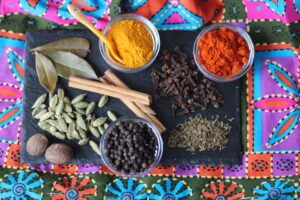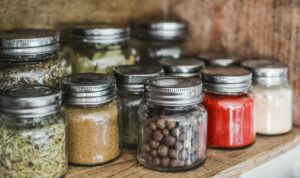For thousands of years, spices have been traditionally used in Indian cooking for three reasons:
1. Their flavour.
2. Their ability to preserve food.
3. Their medicinal properties.
The climate in India has made it ideal for growing a wide variety of spices, and you can see this reflected in the national cuisine. Every region has their flavour combinations, and spice blends are more of an art than a science.
For example, a common spice blend in India is Garam Masala. On a very basic level, it’s a blend containing warming spices, such as cinnamon, clove, cumin, and black pepper. However, every family makes garam masala differently, with different ratios, and adds additional spices, such as cardamom, coriander, mace, ginger, and more. No matter how it’s made, there is no wrong way. The right spice blend is whatever tastes the best to you! Our family has been using the same Garam Masala recipe for generations, and we think it’s pretty great.

Spices are best-stored whole until used and then ground fresh. Whole spices will keep upwards of a year in a sealed container away from heat and light. Ground spices keep 2-3 months before they start losing their aroma and potency.
You can coax a deeper flavour out of spices by blooming or dry roasting. Both are very quick processes. Blooming involves heating ghee until it is hot, and then adding whole spices, allowing them to pop for about a minute before moving on in the recipe. The hot oil penetrates the outer part of the whole spices and brings out the flavour. When dry roasting, make sure a hot skillet is completely free of oil or moisture and then add your spices and toast until aromatic—about a minute or two.
Spices enhance the taste and flavour of food: It’s well known that spices elevate the taste and flavour of food. Just a bit of spice can transform everyday ingredients into an appetizing and aromatic meal. Spices contribute rich flavour to food without adding any calories, fat, sugar or salt. Herbs and spices also add flavours to dishes which, again, increases their complexity but also complements or plays a counterpoint to other flavours already present.
Spices provide nutrition: Derived from plants, spices have a multitude of properties which can positively impact human health. Many spices contain antioxidant, anti-inflammatory, anti-bacterial, and anti-viral properties which have health benefits and benefit the body. For example, ginger and turmeric have anti-inflammatory properties and are widely used in recipes not only for their taste but for these health benefits. Another example spices like cumin and cinnamon which play a role in digestion and can help with weight management. Adding different spices to your meals can certainly help boost your nutrition. If you’re wondering which spices can be considered healthy spices, all of them are! Each with its own set of health benefits.
Spices help in preserving food: In the days when there wasn’t refrigeration or better ways to preserve food, spices helped in the preservation process as many spices have microbial properties. For example, take the instance of smoked meats. The meats were rubbed or dredged in salt, herbs, and spices to preserve and store them for a longer period of time. Up until the 18th century, spices were sought after for their flavour and preservation properties and if one had spices, they were wealthy since many spices came from the Far East and exotic locales. Hence the Spice Islands of India, Indonesia, Africa and South America were colonized by the Dutch, English, Germans, Spanish and French, which led to more exploration for the spice and tea traders.

How to Use Spices in Cooking? To use spices in cooking, whole spices or powdered spices may be used depending on the recipe. A spice mix blend such as garam masala may also be used for a rich, complex flavour. Most spices are flavourful and strong in taste and aroma, so a little goes a long way. You want the spices in your food to enhance the dish you are preparing rather than overpowering it. Always buy fresh spices and store them properly.
Spices are an integral part of our daily diet with a rich history. It’s hard to imagine a single meal without some spice in it. They have been in use for thousands of years not only for their taste-enhancing properties, but also for their health benefits, and food preservation properties. In short, spices are the essence of life – balancing flavours from everyday ingredients and elevating them to a whole new flavour profile while serving our dietary needs and promoting wellness.
